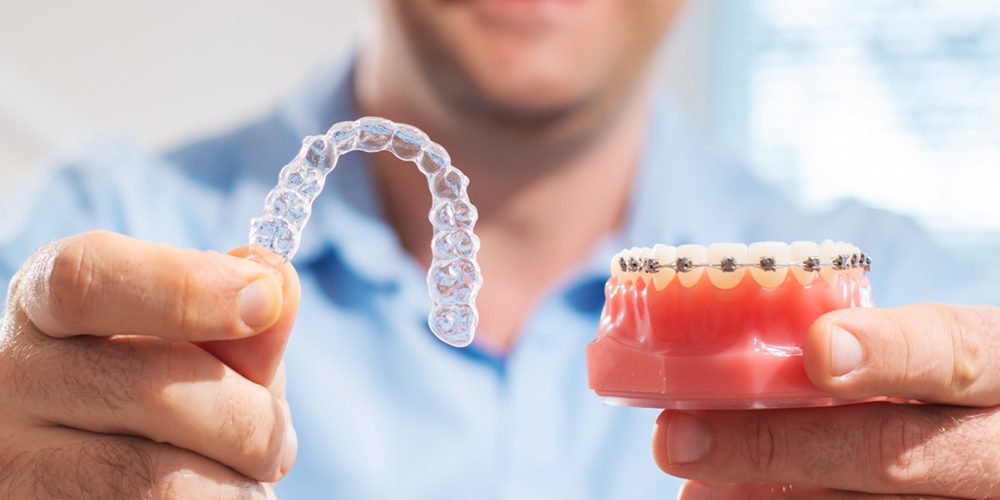As dentists, we are passionate about helping patients achieve a great smile. Crooked teeth can cause people to hide their smile and in turn, lose their confidence. Teeth will move position when steady pressure is applied to them, and the main tools used to achieve this movement are dental braces. There are lots of different kinds of dental braces and dental aligners available depending on what suits your circumstance the best.
Within this blog we will be covering all the key points to know about how to straighten teeth. This includes all the most popular options available to straighten teeth, such as clear braces, metal braces, lingual braces, and ceramic braces, as well the various advantages and disadvantages of these options.
Clear Braces
Clear braces involve utilising a set of clear and removable plastic aligners, which are specifically moulded to your set of teeth. They are made to be invisible and thus are very popular among individuals who want discreet treatment when straightening their teeth. They are not attached to teeth in the same way as traditional braces and therefore, they require even more care and regular maintenance to ensure they are remaining effective. This will mean regular changes of the aligners to ensure they suit your current oral situation.
Advantages of clear braces
- Invisible appearance: Perhaps the biggest benefit of clear braces is the fact they are invisible, and thus the treatment is very discreet
- Removable nature: The removable nature of these braces can be especially beneficial as it avoids foods staining them or any debris remaining inside
- Comfort in the mouth: This form of braces is very comfortable in the mouth and often you forget they are even in your mouth
Disadvantages of clear braces
- Potential inconvenience: There is some potential inconvenience with regards to clear braces, as they will need to be removed before any non-water drink or food is consumed. If you eat/drink throughout the day, then it can become taxing to constantly keep doing so. However, on the other hand patients always comment on how much extra weight they lose!
- Discipline: While they are removable, they also need to be kept in the mouth as long as possible and only removed in certain circumstances. This can require strict discipline, which is difficult, as you may be tempted to keep them out for prolonged periods of time, which reduces effectiveness.
Metal Braces
These braces are the most traditional and well-known form of braces. They utilise small metal brackets which are attached to teeth and kept together using arch wire. They are then manipulated to move teeth into position over time.
Advantages of metal braces
- Inexpensive: This treatment option is among the cheapest options for straightening teeth
- Strong: This form of treatment is extremely sturdy, and they are highly unlikely to break or become unattached to teeth
- Fast treatment: The treatment time for this option is short compared to some other options as they offer strong control over teeth and move them at a fairly quick rate
Disadvantages of metal braces
- Highly visible: A key drawback of these braces are that they are highly visible to other individuals when speaking/smiling, and thus they are not good for those who want discreet treatment
- Potentially restrictive: They can be quite restrictive with regards to what you can eat/drink as they can influence the brackets/arch wire, or lead to potential staining
- Difficult to maintain hygiene: Ensuring that you maintain impeccable oral hygiene can be tough with these braces as they can trap food into hard to reach areas, and this can be problematic in the long run
Lingual braces
Lingual braces are very similar to metal braces although a key difference is that they are not fitted to the front surface of teeth, and instead they are placed on the behind surface of teeth. Apart from this, they work in the exact same way as metal braces.
Advantages of lingual braces
- Strength: Like the metal braces these are very strong and will be unlikely to break or become unattached from teeth over time
- Visibility: A major advantage that these braces have over some other options are that they are not visible, and thus can be a very discreet form of treatment
Disadvantages of lingual braces
- Restrictions: Like metal braces you will have major restrictions on what you can eat/drink, so hard/sticky foods will have to be avoided
- Price: This form of treatment can be on the fairly expensive side, as it requires more technique from the dentist to implement them
- They can be a lot more uncomfortable compared to other types of braces. Some patients develop ulcers on their tongues
- Patients often develop a lisp
Ceramic braces
These braces are quite similar to metal braces, with the only clear difference being that they are made from ceramic. Subsequently, they more closely match the colour of teeth, and thus are a discreet form of treatment.
Advantages of ceramic braces
- Visibility: While the braces themselves do have some visibility, as they are coloured similar to teeth, they are quite discreet
- Length of treatment: The treatment itself is swift, compared to other options such as clear braces
Disadvantages of ceramic braces
- Size: These braces can potentially be quite big, especially compared to metal braces and thus can make cleaning problematic
- Stains: These types of braces are quite susceptible to staining so can restrict your diet to an extent
- Durability: These braces are not as strong as metal braces so they can potentially fracture under pressure
If you would like to discuss treatment to straighten your teeth, we would love you to choose the team at Sensational Smiles to aid you on your journey to a more confident smile.

